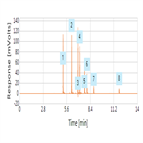Find methods for your needs
Refine by Feature
Displaying 1-2 of 2 results for Tag: dust
AN323: Extraction of Polychlorinated Dibenzo-p-dioxins and Polychlorinated Dibenzofurans from Environmental Samples Using Accelerated Solvent Extraction (ASE)
Instrument Type: Automated Sample PrepPolychlorinated dibenzo-p-dioxins (PCDDs) and polychlorinated dibenzofurans (PCDFs) are toxic at low concentrations and therefore highly regulated. Additionally, these contaminants are difficult to extract. Accelerated Solvent Extraction (ASE) is an equivalent extraction method for U.S. EPA Methods 3545. ASE uses solvents at elevated temperatures and pressures, thereby increasing the extraction efficiency while consuming small amounts of solvent at significantly less time. Here ASE has been used to extract PCDDs and PCDFs from ground chimney brick, urban dust, fly ash, and sediment samples.
Analyzing PBDEs in House Dust Samples with the Thermo Scientific TSQ Quantum XLS Ultra GC-MS/MS in EI-SRM Mode
Instrument Type: GCMSPolybrominated diphenyl ethers (PBDEs) were introduced in the 1960s as flame retardants and are currently used in a wide variety of household apparatuses, consumer electronics, furniture and more. Environmental levels of PBDEs have been continuously increasing due to their special persistence.Due to growing concerns over the health risks from constant exposure to this class of compounds and the accumulation effects in the food chain, suitable analytical methods are required to quantify flame retardant compounds at low levels in a variety of matrices. The new range of Trace Gold Metal colum...


